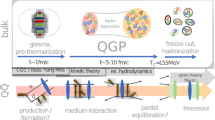Abstract
We study the qualitative and quantitative properties of the spectrum of a two-body hamiltonian with relativistic kinematics. We show that this kinematics leads in a natural way to the observed features of light flavour (u, d, s) spectroscopy. After having established the basic properties of the operator (p 2+m 2)1/2+V(r) in the cases of linear or logarithmic potentials, we show that, to first approximation, all\(q_1 \bar q_2\) meson states can be reproduced with a very simple universal flavour-independent potential whose parameters are directly related to basic physical quantities: the Regge slopes of light flavours and the quasi-logarithmic coupling strength of heavy quarks. We can derive equivalent effective non-relativistic hamiltonians which justify the successes of N.R. approaches. The main difficulties encountered, in particular in incorporating spin effects, appear to be due to the fact that, in phenomenological potential models, chiral symmetry and the ensuing Goldstone nature of the pion cannot be implemented in a natural way. Hence, such an approach can take its full predictive power only if it is based on a deeper field-theoretic level.
Similar content being viewed by others
References and Footnotes
T. Appelquist, D.H. Politzer: Phys. Rev. Lett.34, 43 (1975)
E. Eichten et al.: Phys. Rev. Lett.34, 369 (1975)
E. Eichten et al.: Phys. Rev.D 17, 3090 (1978);D 21, 203 (1980)
C. Quigg, J.L. Rosner: Phys. Rep.56, p. 167 (1979) and further references therein
A. Martin: Phys. Lett.93B, 338 (1980)
W. Buchmüller, G. Grunberg, S.-H. Tye: Phys. Rev. Lett.45, 103 (1980);45, 587 (E) (1980)
W. Buchmüller, S.-H. Tye: Phys. Rev.D 24, 132 (1981) and further references therein
W. Buchmüller: Testing QCD in quarkonium spectroscopy, p. 91 in: New Flavours. Moriond workshop, J. Tran Thanh Van, L. Montanet eds. Gif sur Yvette: Frontières 1982, and further references therein
G. Bhanot, S. Rudaz: Phys. Lett.78B, 119 (1978)
J.L. Richardson: Phys. Lett.82B, 272 (1979)
A. Martin: Phys. Lett.100B, 511 (1981), see also A. Martin, J.M. Richard: Phys. Lett.115B, 323 (1982)
S. Ono, F. Schöberl: Phys. Lett.118B, 419 (1982)
H. Grosse, A. Martin: Phys. Rep.C60, 342 (1980)
For recent reviews, see for instance J.M. Richard: Recent developments in heavy quark spectroscopy talk given at “Rencontre de Moriond”, March 1984 (to be published); A. Martin: 1983 Cargèse Institute proceedings (Plenum Press, to appear); S. Ono: Quarkonia, Lectures at the XXIII Cracow School of Theoretical Physics, Zakopane (1983), CERN preprint TH-3679
J.M. Richard: Phys. Lett.100B, 515 (1981)
J.M. Richard, P. Taxil: Ground state baryons in the nonrelativistic quark model Marseille preprint CPT-83/PE 1476 (1983) (to be published)
R.K. Bhaduri, L.E. Cohler, Y. Nogami: Nuovo Cimento65A, 376 (1981); S.N. Jena: Phys. Rev.D 28, 2326 (1983)
F. Schöberl: Z. Phys. C — Particles and Fields15, 261 (1982)
“On passe sa vie à romancer les motifs et à simplifier les faits”, Boris Vian, (free translation “One spends one's time romanticizing motivations and simplifying facts”)
G.'t Hooft: Nucl. Phys.B 75, 461 (1975)
G. Preparata: Phys. Lett.B 102, 327 (1981);B 108, 187 (1982); Nuovo Cimento A,66, 205 (1981); J.L. Basdevant, G. Preparata: Nuovo Cimento A,67, 19 (1982)
A.J. Hanson, R.D. Peccei, M.K. Prasad: Nucl. Phys.B121, 477 (1977), and further references therein
D.P. Stanley, D. Robson: Phys. Rev.D21, 3180 (1980)
J. Carlson, J. Kogut, V.R. Pandharipande: Phys. Rev.D27, 233 (1983), and further references therein
N. Isgur: in New flavours and hadron spectroscopy. proc. of the XVI Rencontre de Moriond, p. 247. J. Tran Thanh Van ed. Gif sur Yvette: Frontières 1981
S. Godfrey, N. Isgur: Mesons with chromodynamics. Toronto preprint (1984)
Attempts have also been made with a Klein-Gordon type equation and a hamiltonian which is unbounded from below, see e.g. J.S. Kang, H.J. Schnitzer: Phys. Rev.D12, 841 (1975); H.J. Schnitzer; Preprint BRX-TH-171 (1984)
J.L. Basdevant, S. Boukraa: Semi-relativistic quark-antiquark potential models. Annales de Physique (to be published)
Review of Particle Properties, April 1984 Edition, Rev. of Mod. Phys. Vol. 56, No 2 Part 2, April 1984
N.I. Muskhelishvili, “Singular Integral Equations”, (North Holland, Amsterdam, 1958), and further references therein
See for instance A. Robinson and J.A. Laurmann, “Wing Theory”, (Cambridge University Press, 1958), p. 193, and K. Karamchetti, “Principles of Ideal Fluid Dynamics”, (New-York, N.Y., 1966)
I.W. Herbst: Comm. Math. Phys.53, 285 (1977)
J.L. Basdevant and G. Preparata, “Relativistic Quarkonium Model”, to be published in the Proceedings of the Lisbon International Conference on High Energy Physics 1981
P. Cea, P. Colangelo, G. Nardulli, G. Paiano, G. Preparata: Phys. Rev.D26, 1157 (1982); P. Cea, G. Nardulli and G. Paiano: Phys. Rev.D28, 2291 (1983); G. Paiano, Nuovo Cim.70A, 339 (1982); P. Cea, G. Nardulli and G. Paiano: Z. Phys. C.19, 321 (1983)
J.L. Basdevant, G. Preparata: unpublished
D. Olivier: Thesis (Paris, 1983), unpublished
The “universal” confining potential shown in Fig. 12 of [25] is easily seen to be too low by ∼400 MeV to reproduce the spectra given in the paper. Furthermore the r.m.s. radii shown in that figure are incorrect
M. Bander, D. Silvermann, B. Klima, U. Maor: Phys. Rev.D29, 2038 (1984); B. Klima, U. Maor: DESY preprint 84-029 (1984)
H. Grosse, A. Martin: Phys. Lett.134B, 368 (1984)
One of us (J.L.B.) is indebted to F. Wagner for a useful remark on this point
A. De Rùjula, H. Georgi, S.L. Glashow: Phys. Rev.D12, 147 (1975)
J.L. Basdevant, P. Colangelo, G. Preparata: Nuovo Cimento71A, 445 (1982)
P. Castorina et al.: Phys. Lett.115B, 487 (1982)
K. Heikkilä, N.A. Törnqvist, S. Ono: Phys. Rev.D29, 110 (1984), and further references therein
Author information
Authors and Affiliations
Additional information
Laboratoire associé au CNRS no 280
Rights and permissions
About this article
Cite this article
Basdevant, J.L., Boukraa, S. Successes and difficulties of unified quark-antiquark potential models. Z. Phys. C - Particles and Fields 28, 413–426 (1985). https://doi.org/10.1007/BF01413604
Received:
Revised:
Issue Date:
DOI: https://doi.org/10.1007/BF01413604




